
Question Number 38397 by Fawomath last updated on 25/Jun/18
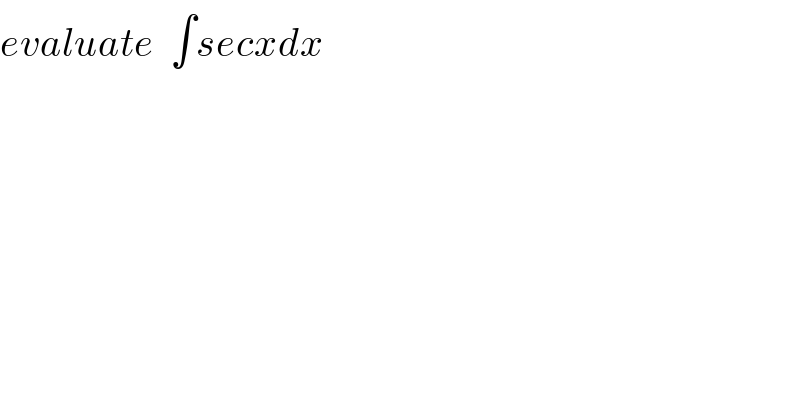
$${evaluate}\:\:\int{secxdx} \\ $$
Commented by maxmathsup by imad last updated on 25/Jun/18
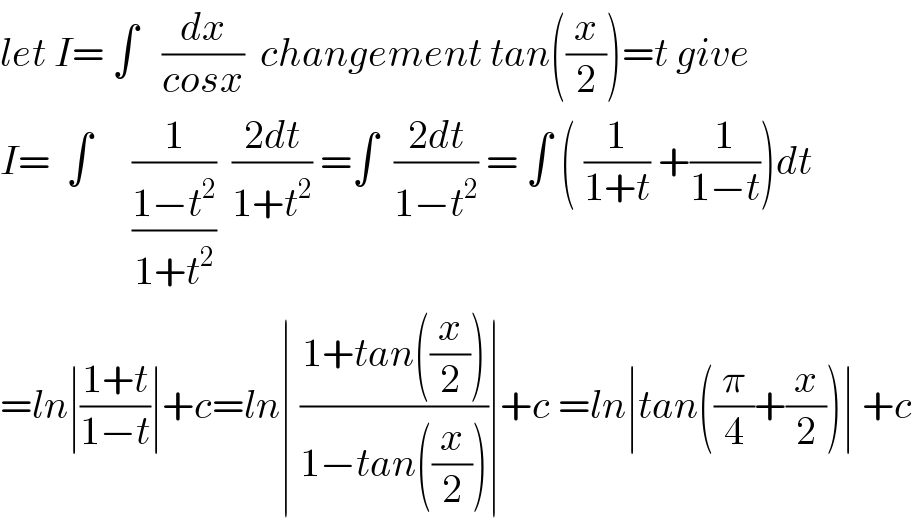
$${let}\:{I}=\:\int\:\:\:\frac{{dx}}{{cosx}}\:\:{changement}\:{tan}\left(\frac{{x}}{\mathrm{2}}\right)={t}\:{give} \\ $$$${I}=\:\:\int\:\:\:\:\:\frac{\mathrm{1}}{\frac{\mathrm{1}−{t}^{\mathrm{2}} }{\mathrm{1}+{t}^{\mathrm{2}} }}\:\:\frac{\mathrm{2}{dt}}{\mathrm{1}+{t}^{\mathrm{2}} }\:=\int\:\:\frac{\mathrm{2}{dt}}{\mathrm{1}−{t}^{\mathrm{2}} }\:=\:\int\:\left(\:\frac{\mathrm{1}}{\mathrm{1}+{t}}\:+\frac{\mathrm{1}}{\mathrm{1}−{t}}\right){dt} \\ $$$$={ln}\mid\frac{\mathrm{1}+{t}}{\mathrm{1}−{t}}\mid+{c}={ln}\mid\:\frac{\mathrm{1}+{tan}\left(\frac{{x}}{\mathrm{2}}\right)}{\mathrm{1}−{tan}\left(\frac{{x}}{\mathrm{2}}\right)}\mid+{c}\:={ln}\mid{tan}\left(\frac{\pi}{\mathrm{4}}+\frac{{x}}{\mathrm{2}}\right)\mid\:+{c} \\ $$
Commented by Cheyboy last updated on 25/Jun/18
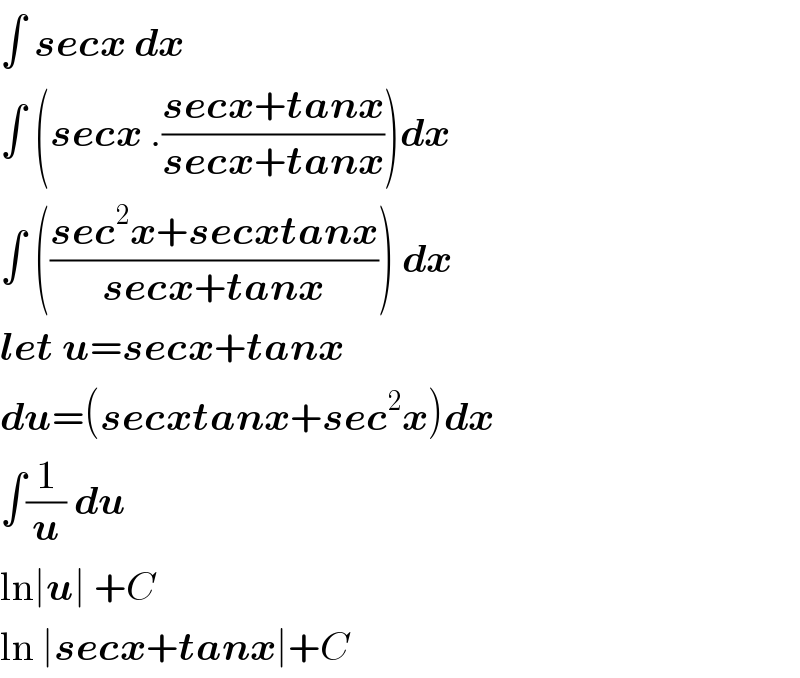
$$\int\:\boldsymbol{{secx}}\:\boldsymbol{{dx}} \\ $$$$\int\:\left(\boldsymbol{{secx}}\:.\frac{\boldsymbol{{secx}}+\boldsymbol{{tanx}}}{\boldsymbol{{secx}}+\boldsymbol{{tanx}}}\right)\boldsymbol{{dx}} \\ $$$$\int\:\left(\frac{\boldsymbol{{sec}}^{\mathrm{2}} \boldsymbol{{x}}+\boldsymbol{{secxtanx}}}{\boldsymbol{{secx}}+\boldsymbol{{tanx}}}\right)\:\boldsymbol{{dx}} \\ $$$$\boldsymbol{{let}}\:\boldsymbol{{u}}=\boldsymbol{{secx}}+\boldsymbol{{tanx}} \\ $$$$\boldsymbol{{du}}=\left(\boldsymbol{{secxtanx}}+\boldsymbol{{sec}}^{\mathrm{2}} \boldsymbol{{x}}\right)\boldsymbol{{dx}} \\ $$$$\int\frac{\mathrm{1}}{\boldsymbol{{u}}}\:\boldsymbol{{du}} \\ $$$$\mathrm{ln}\mid\boldsymbol{{u}}\mid\:+{C} \\ $$$$\mathrm{ln}\:\mid\boldsymbol{{secx}}+\boldsymbol{{tanx}}\mid+{C} \\ $$
Answered by tanmay.chaudhury50@gmail.com last updated on 25/Jun/18
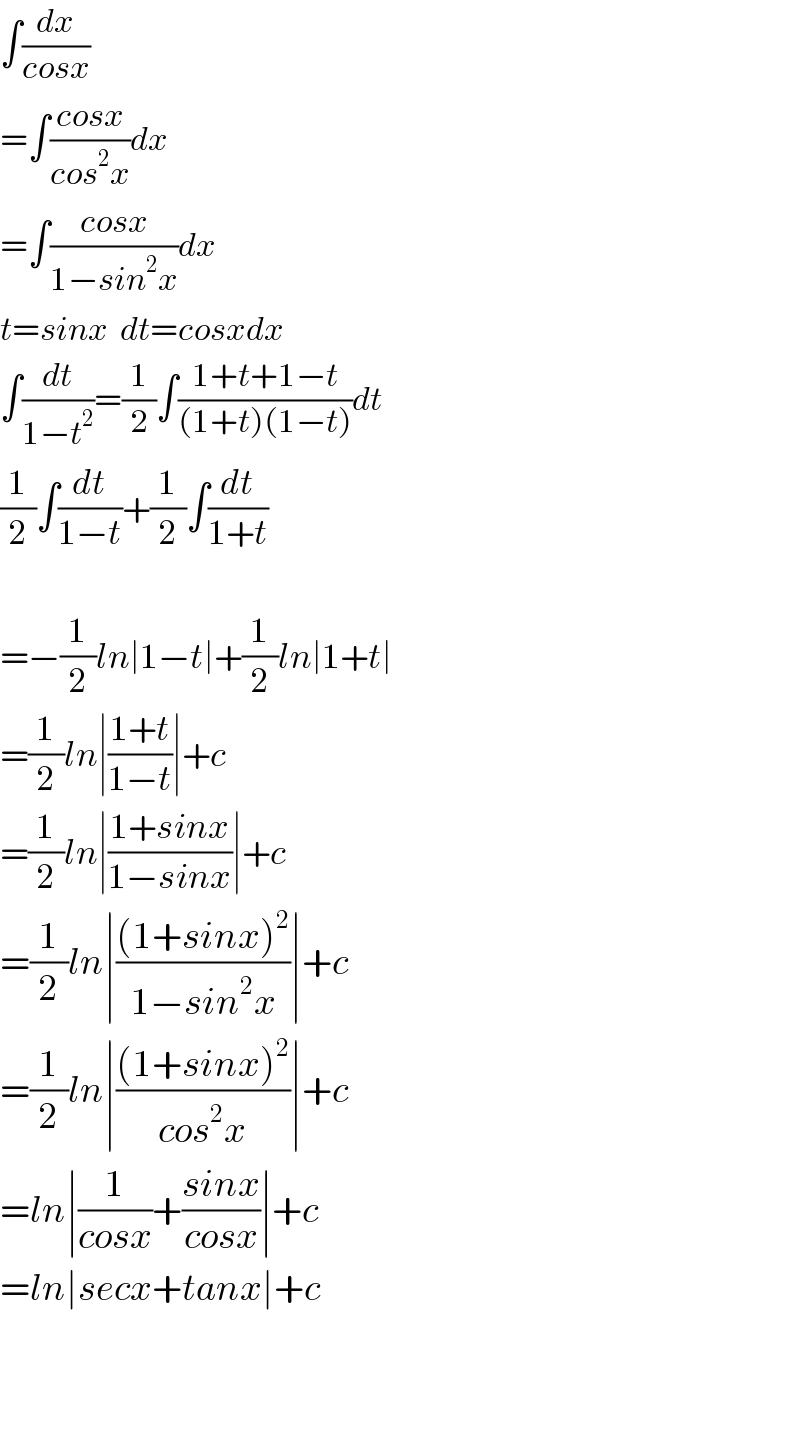
$$\int\frac{{dx}}{{cosx}} \\ $$$$=\int\frac{{cosx}}{{cos}^{\mathrm{2}} {x}}{dx} \\ $$$$=\int\frac{{cosx}}{\mathrm{1}−{sin}^{\mathrm{2}} {x}}{dx} \\ $$$${t}={sinx}\:\:{dt}={cosxdx} \\ $$$$\int\frac{{dt}}{\mathrm{1}−{t}^{\mathrm{2}} }=\frac{\mathrm{1}}{\mathrm{2}}\int\frac{\mathrm{1}+{t}+\mathrm{1}−{t}}{\left(\mathrm{1}+{t}\right)\left(\mathrm{1}−{t}\right)}{dt} \\ $$$$\frac{\mathrm{1}}{\mathrm{2}}\int\frac{{dt}}{\mathrm{1}−{t}}+\frac{\mathrm{1}}{\mathrm{2}}\int\frac{{dt}}{\mathrm{1}+{t}} \\ $$$$ \\ $$$$=−\frac{\mathrm{1}}{\mathrm{2}}{ln}\mid\mathrm{1}−{t}\mid+\frac{\mathrm{1}}{\mathrm{2}}{ln}\mid\mathrm{1}+{t}\mid \\ $$$$=\frac{\mathrm{1}}{\mathrm{2}}{ln}\mid\frac{\mathrm{1}+{t}}{\mathrm{1}−{t}}\mid+{c} \\ $$$$=\frac{\mathrm{1}}{\mathrm{2}}{ln}\mid\frac{\mathrm{1}+{sinx}}{\mathrm{1}−{sinx}}\mid+{c} \\ $$$$=\frac{\mathrm{1}}{\mathrm{2}}{ln}\mid\frac{\left(\mathrm{1}+{sinx}\right)^{\mathrm{2}} }{\mathrm{1}−{sin}^{\mathrm{2}} {x}}\mid+{c} \\ $$$$=\frac{\mathrm{1}}{\mathrm{2}}{ln}\mid\frac{\left(\mathrm{1}+{sinx}\right)^{\mathrm{2}} }{{cos}^{\mathrm{2}} {x}}\mid+{c} \\ $$$$={ln}\mid\frac{\mathrm{1}}{{cosx}}+\frac{{sinx}}{{cosx}}\mid+{c} \\ $$$$={ln}\mid{secx}+{tanx}\mid+{c} \\ $$$$ \\ $$$$ \\ $$
Answered by malwaan last updated on 25/Jun/18
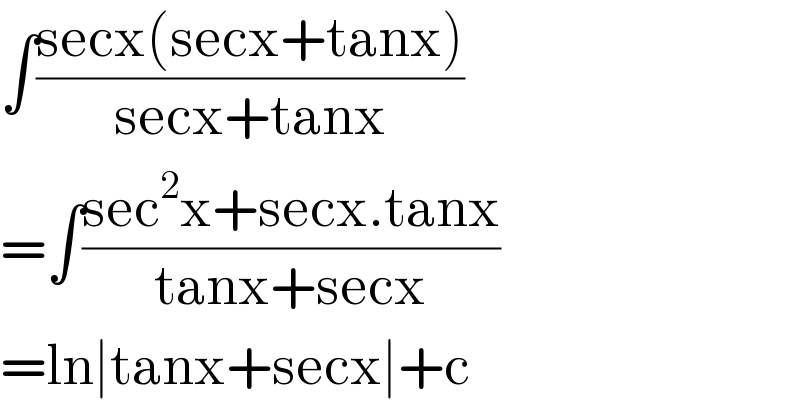
$$\int\frac{\mathrm{secx}\left(\mathrm{secx}+\mathrm{tanx}\right)}{\mathrm{secx}+\mathrm{tanx}} \\ $$$$=\int\frac{\mathrm{sec}^{\mathrm{2}} \mathrm{x}+\mathrm{secx}.\mathrm{tanx}}{\mathrm{tanx}+\mathrm{secx}} \\ $$$$=\mathrm{ln}\mid\mathrm{tanx}+\mathrm{secx}\mid+\mathrm{c} \\ $$
